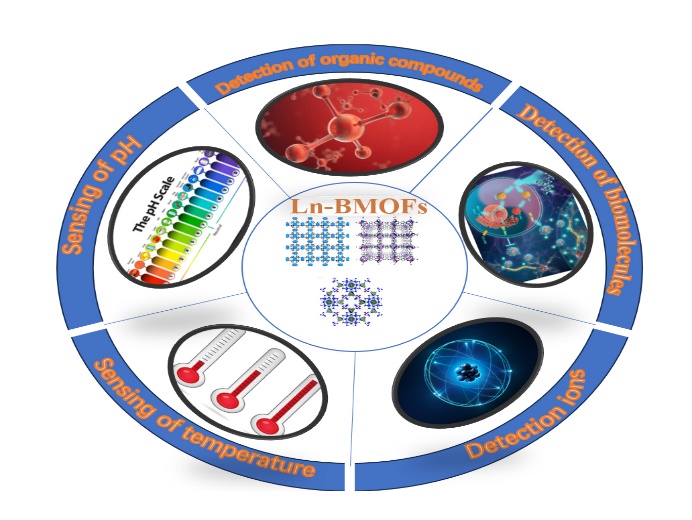

Application of Eu-Tb Lanthanide Bimetallic Organic Frameworks in Fluorescence Sensing
Received date: 2024-06-05
Revised date: 2024-09-27
Online published: 2025-03-10
Supported by
Ministry of Public Security Science and Technology Strengthening Police Basic Work Project(2022JC03)
Ministry of Public Security Science and Technology Strengthening Police Basic Work Project(2023JC05)
Criminal Investigation Police University of China Scientific Research Project(D2022044)
Eu-Tb lanthanide bimetallic organic frameworks (Ln-BMOFs) are inorganic organic hybrid materials with a periodic network structure and functional diversification,which are composed of lanthanide Eu-Tb as the center and organic ligands. It has unique luminescence characteristics,especially sharp absorption,and large Stokes displacement,which makes it exhibit excellent performance in the field of fluorescence sensing. By adjusting the ratio of Eu and Tb in MOFs,we can obtain a series of EuxTb1-x doped MOFs with different luminous colors,and containing different proportions of Eu and Tb,which have similar or different luminous sensing mechanisms. Since the Eu-Tb lanthanide bimetallic organic frameworks have important research value in the field of fluorescence sensing,this paper will comprehensively and systematically review the research progress of lanthanide bimetallic organic frameworks from the aspects of background,sensing mechanism and application of fluorescence sensing.
Contents
1 Introduction
2 Luminescence and sensing mechanisms
2.1 Energy transfer
2.2 Changes in the coordination environment
3 Luminescence sensing applications
3.1 Detection of organic compounds
3.2 Detection of biomolecules
3.3 Detection of ions
3.4 Sensing of temperature and pH
4 Conclusions and prospects

Zongxing Wang , Yue Zhang , Pengcheng Zhao , Yifei Wang , Ce Nan , Zhiyue Zhang . Application of Eu-Tb Lanthanide Bimetallic Organic Frameworks in Fluorescence Sensing[J]. Progress in Chemistry, 2025 , 37(4) : 612 -620 . DOI: 10.7536/PC240526
图8 (a)Tb0.94Eu0.06-HS的发光颜色[75];(b,c)在50~300 K范围内Eu0.01Tb0.99-BDC-F4的发射光谱和CIE图[76];(d)Eu0.05Tb0.95-OBA在pH为1~13的HCl或NaOH溶液中的发射光谱[79]Fig.8 (a) Luminous color of Tb0.94Eu0.06-HS[75]. Copyright 2024,American Chemical Society. (b,c)Emission spectrum and CIE diagram of Eu0.01Tb0.99-BDC-F4 in the range of 50-300 K[76]. Copyright 2020,Elsevier. (d)Eu0.05Tb0.95-OBA in HCl or NaOH solutions with pH 1-13 of emission spectra[79]. Copyright 2021,Royal Society of Chemistry |
| [1] |
|
| [2] |
|
| [3] |
|
| [4] |
|
| [5] |
|
| [6] |
|
| [7] |
|
| [8] |
|
| [9] |
|
| [10] |
|
| [11] |
|
| [12] |
|
| [13] |
|
| [14] |
|
| [15] |
|
| [16] |
(白刚, 何宁, 沈敦璞, 张晓梅, 高明亮, 赵鹏程. 化学世界, 2019, 60: 538.).
|
| [17] |
|
| [18] |
|
| [19] |
|
| [20] |
|
| [21] |
|
| [22] |
|
| [23] |
|
| [24] |
|
| [25] |
|
| [26] |
|
| [27] |
|
| [28] |
|
| [29] |
|
| [30] |
|
| [31] |
|
| [32] |
|
| [33] |
|
| [34] |
|
| [35] |
|
| [36] |
|
| [37] |
|
| [38] |
|
| [39] |
|
| [40] |
|
| [41] |
|
| [42] |
|
| [43] |
|
| [44] |
|
| [45] |
|
| [46] |
|
| [47] |
|
| [48] |
|
| [49] |
|
| [50] |
|
| [51] |
|
| [52] |
|
| [53] |
|
| [54] |
|
| [55] |
|
| [56] |
|
| [57] |
|
| [58] |
|
| [59] |
|
| [60] |
|
| [61] |
|
| [62] |
|
| [63] |
|
| [64] |
|
| [65] |
|
| [66] |
|
| [67] |
|
| [68] |
|
| [69] |
|
| [70] |
|
| [71] |
|
| [72] |
|
| [73] |
|
| [74] |
|
| [75] |
|
| [76] |
|
| [77] |
|
| [78] |
|
| [79] |
|
/
| 〈 |
|
〉 |